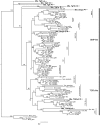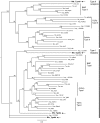Evolution of the TGF-β signaling pathway and its potential role in the ctenophore, Mnemiopsis leidyi
- PMID: 21931657
- PMCID: PMC3169577
- DOI: 10.1371/journal.pone.0024152
Evolution of the TGF-β signaling pathway and its potential role in the ctenophore, Mnemiopsis leidyi
Abstract
The TGF-β signaling pathway is a metazoan-specific intercellular signaling pathway known to be important in many developmental and cellular processes in a wide variety of animals. We investigated the complexity and possible functions of this pathway in a member of one of the earliest branching metazoan phyla, the ctenophore Mnemiopsis leidyi. A search of the recently sequenced Mnemiopsis genome revealed an inventory of genes encoding ligands and the rest of the components of the TGF-β superfamily signaling pathway. The Mnemiopsis genome contains nine TGF-β ligands, two TGF-β-like family members, two BMP-like family members, and five gene products that were unable to be classified with certainty. We also identified four TGF-β receptors: three Type I and a single Type II receptor. There are five genes encoding Smad proteins (Smad2, Smad4, Smad6, and two Smad1s). While we have identified many of the other components of this pathway, including Tolloid, SMURF, and Nomo, notably absent are SARA and all of the known antagonists belonging to the Chordin, Follistatin, Noggin, and CAN families. This pathway likely evolved early in metazoan evolution as nearly all components of this pathway have yet to be identified in any non-metazoan. The complement of TGF-β signaling pathway components of ctenophores is more similar to that of the sponge, Amphimedon, than to cnidarians, Trichoplax, or bilaterians. The mRNA expression patterns of key genes revealed by in situ hybridization suggests that TGF-β signaling is not involved in ctenophore early axis specification. Four ligands are expressed during gastrulation in ectodermal micromeres along all three body axes, suggesting a role in transducing earlier maternal signals. Later expression patterns and experiments with the TGF-β inhibitor SB432542 suggest roles in pharyngeal morphogenesis and comb row organization.
Conflict of interest statement
Figures











Similar articles
-
Genomic organization, evolution, and expression of photoprotein and opsin genes in Mnemiopsis leidyi: a new view of ctenophore photocytes.BMC Biol. 2012 Dec 21;10:107. doi: 10.1186/1741-7007-10-107. BMC Biol. 2012. PMID: 23259493 Free PMC article.
-
Genomic insights into Wnt signaling in an early diverging metazoan, the ctenophore Mnemiopsis leidyi.Evodevo. 2010 Oct 4;1(1):10. doi: 10.1186/2041-9139-1-10. Evodevo. 2010. PMID: 20920349 Free PMC article.
-
Developmental expression of homeobox genes in the ctenophore Mnemiopsis leidyi.Dev Genes Evol. 2008 Jun;218(6):307-19. doi: 10.1007/s00427-008-0222-3. Epub 2008 May 27. Dev Genes Evol. 2008. PMID: 18504608
-
Whole-Body Regeneration in the Lobate Ctenophore Mnemiopsis leidyi.Genes (Basel). 2021 Jun 5;12(6):867. doi: 10.3390/genes12060867. Genes (Basel). 2021. PMID: 34198839 Free PMC article. Review.
-
Brief History of Ctenophora.Methods Mol Biol. 2024;2757:1-26. doi: 10.1007/978-1-0716-3642-8_1. Methods Mol Biol. 2024. PMID: 38668961 Review.
Cited by
-
Multigenerational laboratory culture of pelagic ctenophores and CRISPR-Cas9 genome editing in the lobate Mnemiopsis leidyi.Nat Protoc. 2022 Aug;17(8):1868-1900. doi: 10.1038/s41596-022-00702-w. Epub 2022 Jun 13. Nat Protoc. 2022. PMID: 35697825 Review.
-
Bone morphogenetic protein signaling regulation of AMPK and PI3K in lung cancer cells and C. elegans.Cell Biosci. 2022 May 31;12(1):76. doi: 10.1186/s13578-022-00817-3. Cell Biosci. 2022. PMID: 35641992 Free PMC article.
-
Phylogenetic origins of brain organisers.Scientifica (Cairo). 2012;2012:475017. doi: 10.6064/2012/475017. Epub 2012 Jul 3. Scientifica (Cairo). 2012. PMID: 24278699 Free PMC article. Review.
-
Activin and BMP Signaling Activity Affects Different Aspects of Host Anti-Nematode Immunity in Drosophila melanogaster.Front Immunol. 2021 Dec 22;12:795331. doi: 10.3389/fimmu.2021.795331. eCollection 2021. Front Immunol. 2021. PMID: 35003118 Free PMC article.
-
Morphological and dietary changes encoded in the genome of Beroe ovata, a ctenophore-eating ctenophore.NAR Genom Bioinform. 2024 Jun 18;6(2):lqae072. doi: 10.1093/nargab/lqae072. eCollection 2024 Jun. NAR Genom Bioinform. 2024. PMID: 38895105 Free PMC article.
References
-
- Derynck R, Jarrett JA, Chen EY, Eaton DH, Bell JR, et al. Human transforming growth factor-beta complementary DNA sequence and expression in normal and transformed cells. Nature. 1985;316:701–705. - PubMed
-
- Kingsley DM. The TGF-β superfamily: new members, new receptors, and new genetic tests of function in different organisms. Genes Dev. 1995;8:133–146. - PubMed
-
- Massague J. TGF-β signal transduction. Annu Rev Biochem. 1998;67:753–791. - PubMed
-
- Massague J, Blain SW, Lo RS. TGFB signaling in growth control, cancer, and heritable disorders. Cell. 2000;103:295–309. - PubMed
-
- Herpin A, Lelong C, Favrel P. Transforming growth factor-β-related proteins: an ancestral and widespread superfamily of cytokines in metazoans. Dev Comp Immunol. 2004;28:461–485. - PubMed
Publication types
MeSH terms
Substances
Associated data
- Actions
- Actions
- Actions
- Actions
- Actions
- Actions
- Actions
- Actions
- Actions
- Actions
- Actions
- Actions
- Actions
- Actions
- Actions
- Actions
- Actions
- Actions
- Actions
- Actions
Grants and funding
LinkOut - more resources
Full Text Sources
Miscellaneous

